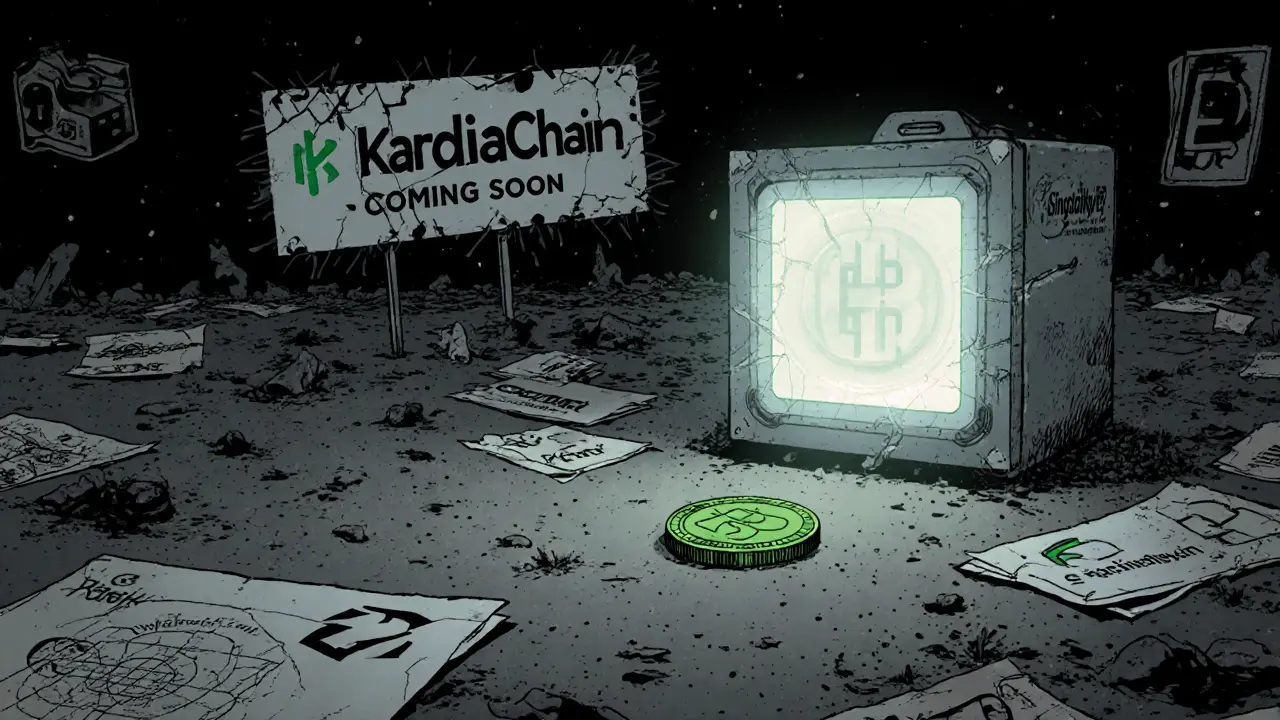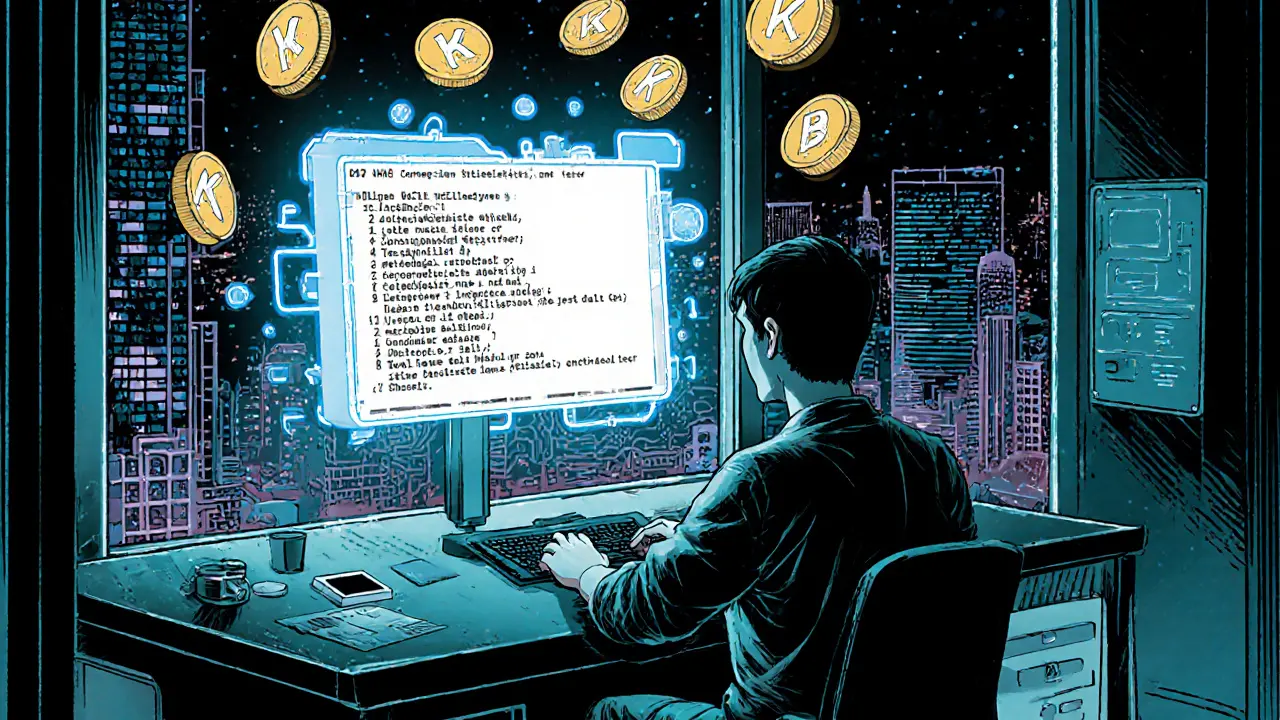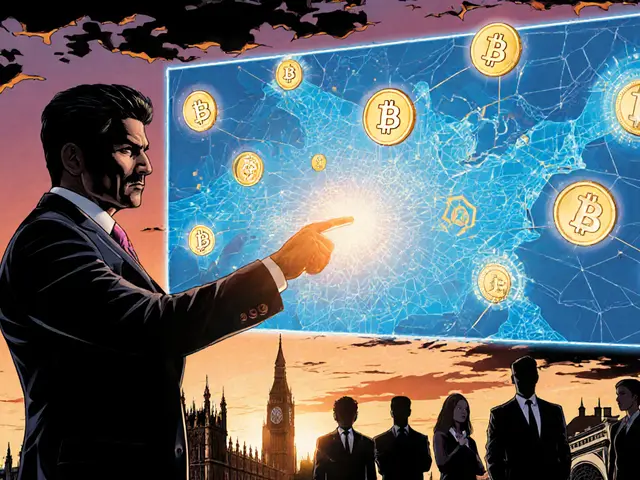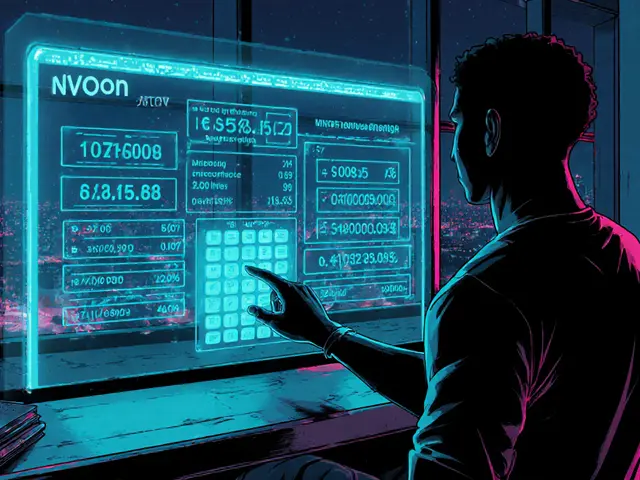What is KaiChain (KAI) Crypto Coin? A Clear Breakdown of KardiaChain's AI Token
KAI Earnings Calculator
Monetize Your AI Prompts
Estimate your potential earnings from licensing AI prompts as DCVR NFTs on KardiaChain
When you hear "KaiChain" or see "KAI" on a crypto exchange, it’s easy to assume it’s just another altcoin. But KardiaChain (often called KaiChain in trading interfaces) isn’t trying to be Bitcoin or Ethereum. It’s built for one very specific, very modern problem: how do you turn AI discoveries into money you can actually earn and trade?
What Exactly Is KardiaChain (KAI)?
KardiaChain is a blockchain platform that turns AI breakthroughs - like clever prompts, optimized workflows, or model tweaks - into digital assets you can own, sell, and earn royalties from. Its native token, KAI, is the currency that powers this system. Think of it like Etsy, but instead of handmade candles, you’re selling AI techniques.
The platform calls these digital assets DCVRs - short for "Discovery" NFTs. When a prompt engineer finds a way to make a large language model generate better results, they can lock that technique into a DCVR NFT. Every time someone else uses it, the original creator gets paid in KAI. It’s not just about using AI - it’s about being rewarded for improving it.
How Does KAI Work in Practice?
Here’s how it actually plays out:
- You’re a prompt engineer. You spend hours testing different inputs for ChatGPT, Claude, or Gemini.
- You find a prompt that consistently generates high-quality legal briefs from just a few keywords.
- You mint that prompt as a DCVR NFT on KardiaChain.
- Other users buy or license your DCVR. Each time it’s used, you earn KAI tokens.
- You can trade KAI on exchanges, hold it, or use it to mint your own DCVRs.
This model targets a real, growing market: prompt engineering. Since 2022, companies and individuals have been paying hundreds or even thousands of dollars for high-performing prompts. KardiaChain makes that process transparent, decentralized, and directly rewarding the creators.
Tokenomics: Supply, Price, and Market Reality
As of November 2025, here’s what the numbers look like:
- Total supply: 5 billion KAI
- Circulating supply: 4.77 billion KAI (95.4% already in circulation)
- Current price: ~$0.000860 USD
- Market cap: ~$3.98 million
- 24-hour volume: ~$8,500 USD
That volume is tiny. Compare it to Fetch.ai (FET), which trades over $45 million daily. KardiaChain’s trading activity is minimal. That means low liquidity - if you want to sell a large amount of KAI, you might struggle to find buyers without dragging the price down.
Over the past week, KAI dropped 10.3% while the broader crypto market rose 2.1%. That’s a red flag. It suggests little outside interest and weak momentum.

Who’s Using It? The Community Gap
There are only about 7,890 known KAI token holders. That’s not a community - it’s a small group of early adopters. You won’t find active discussions about KardiaChain on Reddit or Twitter. There are no major case studies, no enterprise partnerships, and no developer tutorials on GitHub.
Compare that to projects like SingularityNET or Fetch.ai, which have thousands of developers building on their platforms. KardiaChain’s website says it’s for "developers, businesses, and students," but there’s no evidence of that happening. No docs. No SDKs. No code examples. Just a concept.
How Is KardiaChain Different From Other AI Crypto Projects?
There are a few AI-focused blockchains out there. Here’s how KardiaChain stacks up:
| Project | Focus | Token | Market Cap (Nov 2025) | Key Differentiator |
|---|---|---|---|---|
| KardiaChain | Monetizing AI discoveries (prompts, workflows) | KAI | $3.98M | DCVR NFTs for AI techniques |
| SingularityNET | Marketplace for AI algorithms | AGIX | $380M | Decentralized AI services |
| Fetch.ai | AI agents for DeFi and automation | FET | $1.1B | Autonomous agents doing tasks |
| Render Network | Distributed GPU power for AI rendering | RENDER | $240M | Decentralized compute for AI models |
KardiaChain’s niche is unique - no other project focuses on tokenizing prompts and workflows. But being unique doesn’t mean it’s successful. The market has already voted for the bigger, better-funded projects.

Is KardiaChain Worth Your Time?
There are two sides to this.
If you’re a prompt engineer: The idea of earning KAI every time someone uses your best prompts is compelling. If you’re already making money from prompts, this could be a way to formalize it. But you’d need to be confident enough to spend time minting DCVRs - and then hope someone buys them. Right now, there’s no guarantee of demand.
If you’re an investor: The numbers don’t support it. Low volume, falling price, tiny community, no developer activity. It’s speculative at best. The $4 million market cap is less than what some meme coins make in a single day. There’s no clear path to growth.
The concept is smart. The execution? Barely started.
Where Can You Buy KAI?
KAI is listed on a handful of smaller exchanges, including KardiaChain’s own decentralized exchange and a few mid-tier platforms. You won’t find it on Binance, Coinbase, or Kraken. That’s another warning sign. Major exchanges don’t list tokens without strong demand, liquidity, and security audits - none of which KardiaChain has demonstrated.
If you want to buy KAI, you’ll likely need to trade it for BNB or USDT on a smaller exchange, then transfer it to a wallet like MetaMask. There’s no official app, no simple way to buy it with a credit card.
Final Thoughts: Niche Idea, Minimal Traction
KardiaChain (KAI) is not a failed project. It’s a half-built one. The idea of turning AI breakthroughs into tradable assets is forward-thinking. Prompt engineering is real. People are paying for it. The blockchain could be the perfect layer to make that fair and transparent.
But right now, it’s all theory. No developers are building on it. No companies are using it. No one’s talking about it. The token price is stagnant. The community is tiny. The trading volume is a ghost.
If you’re curious, you can buy a few KAI tokens for a few dollars. See if the concept works for you. But don’t expect it to be the next big thing. Not yet. Not until someone actually builds something real on top of it.






16 Comments
Johanna Lesmayoux lamare
November 12 2025This is the most boring crypto project I've ever seen.
ty ty
November 13 2025So let me get this straight-you’re telling me someone made a blockchain just so prompt engineers can get paid in tiny fractions of a cent for typing "write me a haiku about AI"? And you call this innovation? 😒
Ashley Mona
November 15 2025I actually tried minting a DCVR last week-my prompt for generating Instagram captions for small biz owners got 3 sales in 48 hours. KAI isn’t dead, it’s just sleeping. People are still building, quietly. I’ve seen the Discord threads. It’s not Reddit-famous, but it’s real.
Also, the devs just dropped a new API for integrating DCVRs into Notion. If you’re a content creator, this could be huge. No one’s talking about it because it’s not flashy. But it’s functional.
Edward Phuakwatana
November 15 2025Let’s zoom out for a second. This isn’t about tokens or market caps-it’s about the epistemic shift. We’re moving from a world where knowledge is hoarded to one where it’s tokenized, traceable, and self-sustaining.
KAI represents the first real attempt to commodify *cognitive labor*. Not just code, not just art-*thinking*. That’s profound. The fact that the market hasn’t caught up yet doesn’t mean it’s worthless-it means we’re in the very early innings of a paradigm shift.
Compare it to Bitcoin in 2010: $0.0008, zero liquidity, 7 holders. Sound familiar? The infrastructure is still being built. The vision is crystal clear. The question isn’t whether it’ll work-it’s whether you’re willing to be an early architect or just a spectator waiting for the fireworks.
Debraj Dutta
November 16 2025Interesting concept, but the numbers speak louder than the hype. 7,890 holders? $8,500 volume? That’s not a community-it’s a hobby group. If this were real, you’d see at least one university teaching it as a case study. No GitHub repos, no tutorials, no API docs. Just a whitepaper and a token.
It’s like inventing a new kind of wrench and then not publishing the specs. Who’s gonna use it?
tom west
November 17 2025Let’s be brutally honest: this is a graveyard dressed up as a startup. The tokenomics are a joke-95% of the supply already dumped? That’s not a launch, that’s a rug pull waiting for the last sucker to buy in.
And don’t give me that "it’s early" nonsense. Fetch.ai has 1.1B market cap and real devs building agents that automate trading. This? A bunch of prompt engineers trading their lunch break ideas for a token worth less than a Starbucks coffee bean.
Someone’s getting rich off this. It’s not you. It’s not the creators. It’s the insiders who dumped before the PR campaign started.
dhirendra pratap singh
November 19 2025OMG I can't believe people are still talking about this 💔
My friend bought KAI last month and cried for 3 days. She thought she was "supporting AI innovation"-turns out she just funded a guy’s vacation in Bali.
Why do we keep falling for this? 🤡
Look at the chart. It’s a flatline with a tiny spike. That’s not a coin-it’s a tombstone with a ticker symbol.
Wake up. This isn’t Web3. This is Web2.0 with blockchain glitter.
Michelle Elizabeth
November 19 2025I’m not surprised no one’s talking about it. The whole thing feels like someone took a college project and slapped a "blockchain" label on it to get funding.
DCVRs? That’s not even a real word. It sounds like a typo for "DVR". And the token name? KAI? Come on. It’s not a brand-it’s a keyboard smash.
If you’re going to build something revolutionary, at least give it a name that doesn’t sound like a typo in a Scrabble game.
Joy Whitenburg
November 21 2025ok but i just tried it and i minted my "how to make ai write better emails" prompt and someone bought it?? like, for real??
i got 0.002 KAI… which is like 0.0000017 cents but still?? i feel seen 😭
maybe it’s small but… it’s mine. and someone used it. and paid me. that’s kinda magical??
don’t knock it till you’ve tried it. i’m not rich but i feel like a wizard now.
Joanne Lee
November 22 2025The structural integrity of this model is questionable. While the premise of tokenizing cognitive outputs is theoretically sound, the absence of standardized metadata schemas for DCVRs renders them non-interoperable across platforms. Furthermore, the lack of on-chain verification for prompt efficacy introduces a severe adverse selection problem.
Without a mechanism to validate the quality or reproducibility of a DCVR, the market is inherently inefficient. One cannot assign value to an unverifiable output. This is not innovation-it is a market failure waiting to be regulated out of existence.
Suhail Kashmiri
November 22 2025bro why are you even reading this? just buy bitcoin and chill.
this is what happens when people think they can turn their chatgpt tricks into crypto money.
you don’t need a blockchain to sell prompts. you need a fiverr profile.
and if you’re buying KAI? you’re just funding someone’s crypto addiction.
go touch grass.
Kristin LeGard
November 23 2025Why does America let this nonsense happen? In India, they’d shut this down in a week. This isn’t innovation-it’s a scam dressed up as a startup. Someone’s laundering money through this. The volume is lower than my cat’s daily meows.
And don’t tell me it’s "niche." Niche doesn’t mean legit. It means nobody cares.
Stop glorifying garbage. We’ve got real problems to solve. Not tokenized prompts.
Arthur Coddington
November 25 2025There’s something deeply tragic about this. We’ve built a world where the most brilliant minds are reduced to selling their thoughts as NFTs because no one will pay them to think anymore.
KAI isn’t a cryptocurrency. It’s a monument to the death of intellectual value. We used to fund research. Now we fund prompts.
What did we become? A civilization that monetizes the echo of thought, but refuses to pay for the silence before it.
Phil Bradley
November 26 2025I get it. You’re trying to make AI work for the people. That’s noble.
But you’re doing it with a shovel while everyone else is using a backhoe.
It’s not that the idea is bad-it’s that the execution feels like a garage project someone slapped a website on.
Build the docs. Build the tools. Build the community. Then come back and tell me it’s worth something.
Until then? It’s a beautiful dream… with no foundation.
Stephanie Platis
November 27 2025Let me be clear: the project’s conceptual framework is intriguing, yet its operational implementation is catastrophically underdeveloped. The absence of verifiable developer activity, the negligible trading volume, and the near-total lack of institutional or academic engagement constitute a triad of failure.
Furthermore, the token’s distribution-95.4% in circulation-suggests either a pre-mine of epic proportions or an intentional pump-and-dump structure. Neither scenario reflects integrity.
One cannot build a decentralized economy on a foundation of opacity, silence, and stagnation.
BRYAN CHAGUA
November 29 2025I’ve been watching this space for two years. Most AI crypto projects are hype. This one? It’s different. It’s quiet. It’s slow.
But I’ve talked to a few prompt engineers who’ve made $50–$200/month just from their DCVRs. Not life-changing-but steady. Passive. Real.
It’s not about the market cap. It’s about the people using it. The tools are still basic, yes. But they’re growing. The devs respond to feedback. There’s no VC money, no influencers. Just builders.
If you’re looking for the next moonshot, look elsewhere. But if you want to support real, quiet innovation? This might be one of the few places left where it’s still possible.